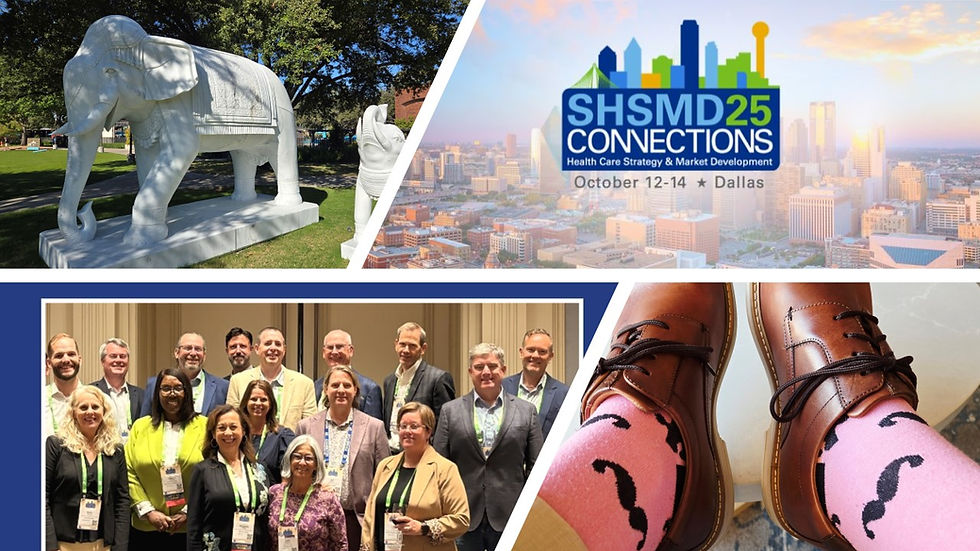Somewhere else is always better. Except maybe when it comes to providing your healthcare
- Alan Shoebridge

- Oct 31, 2021
- 3 min read
Updated: Nov 2, 2021

“Somewhere else is always better.” OK, I am chopping up a movie quote a bit here, but please allow me some artistic license because that is the best way to sum up how many industry observers think about healthcare. Today, the “somewhere else” that is always better than your doctor's office or local hospital is retail.
Just about every organization with a storefront is looking at primary care, health and wellness promotion, and other healthcare services and thinking they can do those things better than the incumbents and also make lots of money along the way. So, why do those organizations think they can perform better than established healthcare providers? Is it realistic ambition, hubris or something in between?
My career has been spent at large, established healthcare organizations; however, I’m not a defender of the status quo. I support changes to make our care delivery systems better and more accountable to those we serve. If retail organizations can fill care delivery gaps, lower costs and improve health outcomes, I’m all for those improvements. Yet, I’m not fully convinced that they can do those things as quickly and profitably as many people are predicting.
Why? Well, let’s focus on retail pharmacy for this blog post.

Reality check
Have you been to one of the big retail pharmacy chains recently as a customer? I have and here are a few things I observed in the last month as a customer at two different national pharmacy brands in two different states.
They are often slow and inefficient. I filled a prescription online and went to the pharmacy about three days later to pick it up. After standing in line for 10 minutes waiting for the lone pharmacist to see me, I was told my prescription wasn’t quite ready and asked to return the next day. This was not for a complex order. I have also experienced this same situation at another retail pharmacy chain about 75% of the time whenever I needed to fill my simple prescription over two years. It was always a long wait in line followed by an even longer wait to actually get what I was told would be ready for pickup at a specific time.
Supply chains are disrupted. About 50% of the store’s shelves were empty during my recent visit. It was hard to find many essential items. I know this situation is beyond the store’s control given the scarcity of goods everywhere now, but stocking up with the supplies needed to set up primary care services will be quite challenging until they can order them at scale.
Product contradictions abound. I couldn’t find bandages or many types of pain relievers, but what my retail pharmacy did have in stock was alcohol and a massive selection of unhealthy food products. Some pharmacy chains even still sell cigarettes. Can you credibly promote health and wellness, and offer primary care services, with alcohol and cigarettes available just a few aisles away? Will all of the chains be willing to walk away from the money generated by those product sales?
Staffing. Healthcare is experiencing massive labor shortages right now. Recruiting doctors and nurses to staff primary care locations at retail pharmacies will be neither easy nor inexpensive. Furthermore, you’ll be asking those professionals to join retail outlets that are understaffed in all other aspects of their operations. Thinking back to my recent visit, when I looked around the store they were woefully short on employees. My store didn’t even have any human beings to work the registers – it was all self-checkout. The customer experience was terrible.

Where do we go from here?
As with most things in life, expectations for the amazing experience retail pharmacies will provide as primary care providers are overblown. The retail pharmacy companies will find the “healthcare is hard” maxim to be true, but I’m not ruling them out in terms of having long-term success. They will make inroads over time, and I hope they will have a positive impact in expanding access to healthcare services.
It's also true that healthcare systems and retail pharmacy providers are often partnering together on care offerings. Traditional healthcare providers aren’t standing still, and they will be working with all manner of partners to make things easier and more efficient for current patients.
Of course, "something else is always better” until you try it. In reality, it could be better, about the same or even worse. That’s life and the nature of industry disruption. We need to adjust our expectations accordingly.



Comments